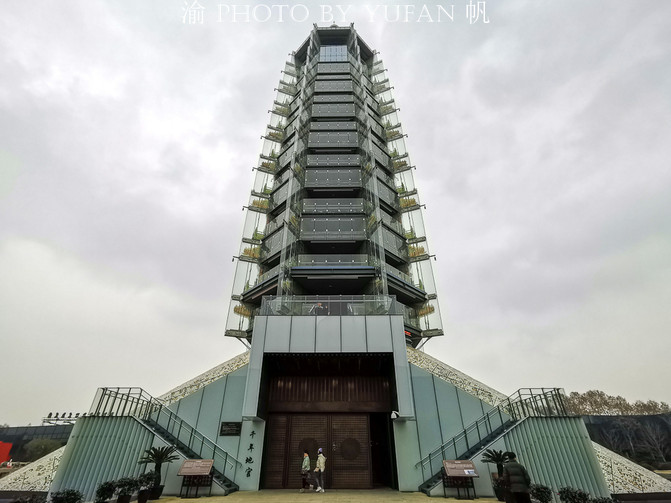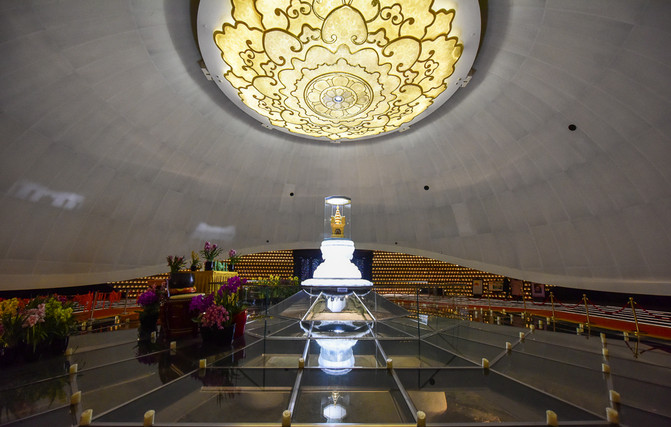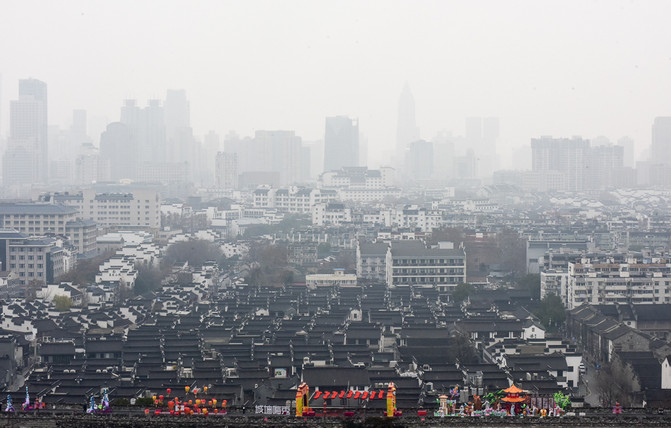China used to be the world's largest tower and called the Seven Wonders of the World together with the Great Wall. Now it has spent 1 billion yuan to rebuild it

When it comes to ancient buildings, people often think of the Seven Wonders of the World immediately. When it comes to the Seven Wonders of the World, Chinese people think of the Great Wall immediately. In fact, the miracles of the World are divided into two categories: the Seven Wonders of the Ancient Times and the Seven Wonders of the Middle Ages. Among them, the Pyramid of Khufu in Egypt, the Hanging Garden of Babylon, the Temple of Artemis, the Colossus of Olympian Zeus, the Mausoleum of Mosolas, the Colossus of the Sun God in Rhode Island, and the Lighthouse of Alexander are listed as the Seven Wonders of the Ancient Times. They were all relatively old and basically destroyed; so later, people proposed the Seven Wonders of the Middle Ages, including the Great Wall of China. However, many people thought that China only had the Great Wall, but they did not know that China had another ancient building. It is also on the same footing as the Great Wall, the Leaning Tower of Pisa, the Colosseum, and the British Stonehenge. It is the Glazed Tower of the Great Baoen Temple, which is known as the "No. 1 Tower in the World".

The first tower in the world-the Glazed Pagoda of Da Bao 'en Temple is located in the Da Bao' en Temple in Nanjing. It was built by Zhu Di, the founder of the Ming Dynasty, to commemorate his mother's tribute to the concubine. It has nine floors and eight sides and is 80 meters high. It is said that the construction of the tower cost a total of 2.485 million taels of silver and more than 100,000 craftsmen and soldiers were invested. It took 20 years. After the tower was completed, a total of 146 boney lanterns were set up inside and outside the nine floors, each with a core about 1 inch thick.

According to staff, there are 146 lights inside and outside the Da Bao 'en Temple Tower, which consumes 64 kilograms of fuel every day. It is splendid and bright day and night. From its completion to its decline, it has been the tallest building in China and is also a miracle in the history of world architecture. During the Ming and Qing Dynasties, some European merchants, tourists and missionaries came to Nanjing and called it the "Nanjing Porcelain Tower", comparing it with the Roman Colosseum, Alexander's Underground Mausoleum, and the Leaning Tower of Pisa. It was a symbol of China at that time. It is also listed as one of the Seven Wonders of the World in the Middle Ages. It is known as "China's great antique and Yongle's great kiln ware" and is known as the "No. 1 Tower in the World".

The reason why it is called the number one tower in the world is that according to Zhu Di, the founder of the Ming Dynasty, there are three unique glazed towers in Dabaoen Temple. One of them is a huge structure and unique shape, towering over the sky. The Glazed Pagoda is one of the tallest buildings in ancient China that is accurately recorded. The tower is octagonal, with a total of 9 floors and a total height of 78.02 meters, which is equivalent to the height of a 26-story building. The second is made of glazed glass, unique in ancient and modern times. The main body of the glazed tower is made of bricks. Except for a "core wood" at the top of the tower,"no inch of wood" is used in the entire building. The three classics are the long and deep night, and the Buddhist lamp is always bright. Whenever dusk approaches, 144 oil lamps as bright as torches will be lit on the glazed tower and will not go out all night long.

Kangxi and Qianlong climbed this tower when they came to Jiangnan in the Qing Dynasty. Emperor Kangxi wrote a poem: "The ground rises from the sky, the sky hangs nine levels, the glass hangs down, and the jade knots around cigarettes. The skills of the people who created it have been passed down from generation to generation. Looking far away, Vientiane arches the sky."Emperor Qianlong also inscribed plaques layer by layer. Even Andersen, who was far away in Denmark, mentioned in "The Garden of Heaven" in 1839:"I (Dongfeng) have just come from China-I danced around the porcelain tower and made all the bells jingle!" The porcelain tower here refers to the glazed tower of Da Baoen Temple (and in the ruins of Da Baoen Temple, there is also a statue of Andersen).


Regrettably, the Pagoda of Dabaoen Temple was destroyed in the fourth year of Xianfeng of the Qing Dynasty (1854). There are two explanations for the reasons for the destruction. One theory is that after the Qing army captured Yuhuatai, the Taiping Army attacked first in order to prevent the Qing army from occupying the Dabaoen Temple and posing a threat to the city. They "blasted it with gunpowder and hollowed out the base under the tower seat. After a few days, the tower fell and the temple was burned." Another story is that in 1856, coinciding with the changes in Tianjing, Wei Changhui, the Northern King, was worried that King Shi Dakai, would occupy the Liuli Tower outside the city. He attacked the city with artillery. He sent troops to dig a tunnel under the tower to detonate explosives, and directly bombarded the tower with artillery. Eventually, the Liuli Tower was turned into a pile of rubble, and other buildings in the Da Baoen Temple were also destroyed by the resulting fire. In addition, some people believed that Zeng Guofan ordered the destruction.

Nowadays, times have changed, and the once miracle of the Middle Ages and the number one tower in the world have long disappeared. This is definitely a great pity for the Chinese people. Therefore, in 2007, the local government decided to rebuild the Dabaoen Temple and the Glass Pagoda, and immediately launched demolition and archaeological work. In 2008, the underground palace of the Changgan Pagoda of the Song Dynasty was discovered at the site of the Liuli Pagoda of the original Dabaoen Temple, and a large number of national-level cultural relics and Buddhist relics such as the true bones of the Buddha's roof and the Qibao Ashoka Pagoda were unearthed. The underground palace of the Changgan Temple must be protected as a national-level cultural relic site. According to the principles of minimum intervention, authenticity and identifiability in the protection of national cultural relics, the original plan for reconstructing the glazed tower must be adjusted. Due to the heavy load on the reconstruction of the glazed tower, the foundation must be excavated, which will inevitably cause damage to the thousand-year underground palace. At the same time, in accordance with the principle of identifiability in cultural relics protection, even if a new tower is rebuilt on the same site, the glazed tower cannot be built again, otherwise it will cause confusion in historical information.

Driven by the local government, after several rounds of expert argumentation and international bidding, it was finally decided to build a new light tower-shaped protected building on the site of the Tutu Palace. The building uses four groups of steel pipe inclined beams to span the sky above the site, and the ground beams are located on the outside of the original tower base site, which not only reduces disturbance to the site, but also protects the underground palace. In order to inherit the historical memory, the protected building was made into a light nine-story tower. Its scale, shape, and length-to-thickness ratio are similar to the original tower. The new tower is named "Da Bao 'en Tower".

It is worth mentioning that the construction of this new Da Bao 'en Temple glass tower also received the attention and support of Wang Jianlin, once the richest man in China and chairman of Wanda Group. He not only donated 1 billion yuan for the construction of the tower, but also personally came to the site when it was built. cut the ribbon.

Although the current Glazed Tower of Dabaoen Temple is no longer the tallest building in China, nor has it lost the glory of the world's number one tower and the seven wonders of the world, it is still a landmark building in the Qinhuai River scenery belt of Confucius Temple in Nanjing. Although it cannot be compared with the ancient tower, it also keeps pace with the times. There are three major innovations, one is structural innovation: In order to avoid disturbance to the site, four groups of steel pipe inclined beams were used to span the top of the site. The left focus of the ground beam was located on the outside of the entire Taki site, forming a new underground palace of "covering bowl" and creating a new place for sacred relics to be worshipped and worshiping space on the original underground palace site. The second is formal innovation: the plan outline of the new tower is in the shape of a lotus petal, containing flowers and vines, and the form of the ancient tower is strengthened through layer division and tower reconstruction, and contemporary technology is used to recreate the ancient charm of the new tower. The third is material innovation: Based on the principle of minimum interference and identifiability for cultural relics protection, the new tower is not allowed to adopt the restored form of ancient towers. The new tower uses advanced steel structures and lightweight materials such as ultra-white glass.

The damage to the ancient tower is regrettable. Although this newly built glass tower that combines the beauty of the ancient tower with modern design is controversial, it is indeed a compromise choice. At least seeing it will remind us that it was once the world's largest tower built by a major country. It was also comparable to the Roman Colosseum, the Great Wall, and the Leaning Tower of Pisa, and is called the Seven Wonders of the World.
Finally, I would like to ask my friends, do you know anything about this Seven Wonders of the World building in Nanjing? Let's have a chat together.
Previous Article:Confucius Temple, Qinhuai River, Liuli Pagoda... How many of the top ten attractions not to be missed in Nanjing have you visited?
Next Article:Nanjing, a thousand-year-old town that flows in poetry, should also be filled with stories
